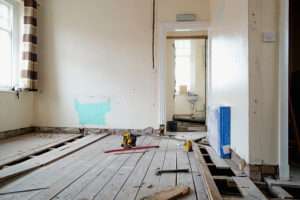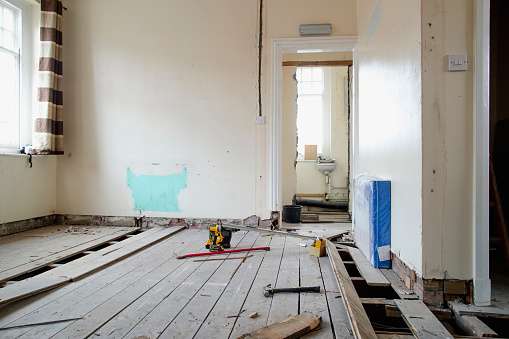This post may contain affiliate links which means I may receive a commission for purchases made through links.
Underfloor heating installation is increasingly becoming a popular method of primary heating and an excellent alternative to radiators. Generally, these systems are simple, quicker, and relatively cheap to install in new builds.

However, most homes are constructed without UFH systems for various reasons such as cost and lack of awareness of their benefits over conventional radiator systems. As a result, many homeowners consider installing these systems once the house is already built.
But, is it possible to install Underfloor heating into an existing house? Well, continue reading this post to learn if retrofitting UFH is a good option for your renovation project!
What’s retrofitting?
By definition, retrofitting refers to the process of adding a system, component, or product after the initial stage of manufacturing. In this case, it’s the process of adding a UFH system to a space in an existing building. This is a great way to bring radiant warmth to an existing house.
Retrofitting Underfloor Heating into an existing/ Old House
Since most electric UFH systems have minimal impact on floor heights, they’re considered the best underfloor heating option for retrofit projects. This is because most of these systems are equipped with ultra-thin wires. For that, they’re ideal for renovations where door levels and ceiling heights are fixed. Even better, electric systems can be installed directly on existing floors within layers of adhesive when installing floor tiles.
Therefore, you can fit electric UFH systems on existing subfloors and old/ new properties. However, in the case of old properties, you have to remove the existing floor finish like vinyl, tile, or laminate and replace it with a new floor finish. In short, fitting UFH onto existing floors involves removing the existing floor surfaces, installing insulation boards, installing the UFH systems, and laying down a new floor finish over it.
As you may have guessed, lifting the existing floor finish and laying the same floor after Underfloor heating installation is very difficult. Not to forget that floor finishes like tiles tend to get damaged when you’re lifting the floor.
All in all, electric UFH is an excellent option if you still wish to change your floor while renovating, thanks to its thinness. For that, it will not visibly raise your floor, plus it’s easy and quick to install. However, make sure you involve a qualified electrician in your project to ensure that the design and electrical distribution of the system are done correctly.
Benefits of retrofitting Underfloor Heating to an existing house
Modern UFH systems provide various benefits to homeowners. First, underfloor heating systems work at a lower temperature, yet offer a gentle and comfortable solution. In return, this plays a significant role in reducing the heating bills.
Secondly, UFH generates radiated heat, since the pipe loops and mats installed beneath the top flooring layer heat up the floor surface above. As a result, objects and people in the rooms are warmed up, as opposed to central heating systems that cause air to rise as it heats and fall when it cools.
On the same note, radiant heating ensures that fewer pollutants and dust are cycled around your house on convection currents. This vastly improves indoor air quality and provides superior energy efficiency.
Another benefit of UFH is that they’re low maintenance and hidden under the floor surface. Therefore, they help to save wall space that would be otherwise occupied by a radiator and save you money in the long run.
Overall, retrofitting Underfloor heating provides better environmental effectiveness, lifespan, and space spacing. In addition, it offers a superior level of control compared to conventional central heating systems as it allows you to use a separate thermostat in individual rooms. This makes them more efficient since the increased level of control allows you to avoid wasting heat and energy on unoccupied rooms.
Can you use Wet UFH systems in underfloor retrofitting?
Over the years, wet/ hydronic underfloor heating systems have developed a reputation of being very difficult to retrofit into an existing house. This is because they’re a thick plastic piping that requires you to dig down into your flooring to accommodate them. In addition, it will significantly reduce the floor-to-ceiling height, causing the floor to rise above the skirting boards.
Due to advancements in manufacturing techniques, there are low-profile wet UFH versions that are easier to fit into existing houses. Such systems will significantly lower the running costs if your property has a main gas and a modern & efficient boiler.
Things to consider when retrofitting Underfloor heating
Like any other home improvement project, planning and preparation are important when retrofitting underfloor heating systems. The pipework mostly runs within the pre-grooved channels, which involves securing the pipe. Also, the pipe layout is more flexible. This makes it different from screeded systems in new-build projects. Even better, careful planning and a comprehensive design will ensure that everything goes to plan.
Secondly, it’s important to consider the type of UFH systems concerning the floor finish. In most cases, plyboard or chipboard are laid on top of grooved polystyrene systems to form a solid base for the subfloor. However, this doesn’t apply to solid engineered wooden flooring as it can be laid directly over the polystyrene UFH system.
Conclusion
How to deal with the existing floor finish is usually the major challenge for underfloor heating installation in renovation projects. In most cases, you should rip out the existing floor finish and start again. This allows you to keep the floor level where it is wanted and creates space for insulation. Overall, installing UFH in existing homes will create comfortable indoor environment for several years to come.
